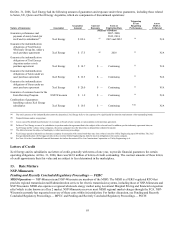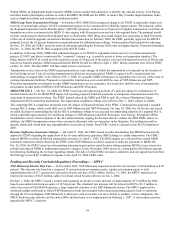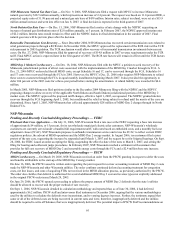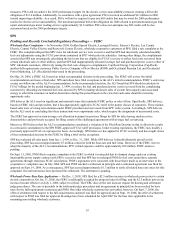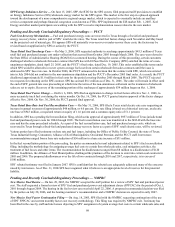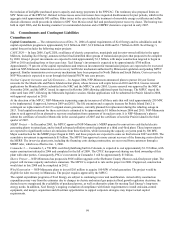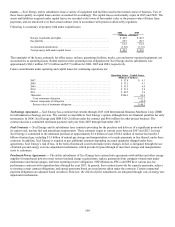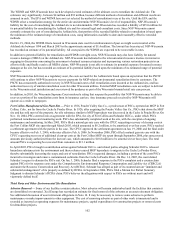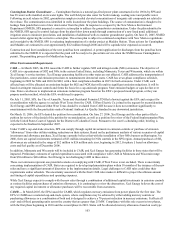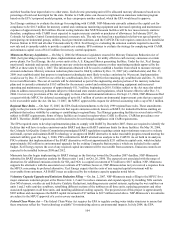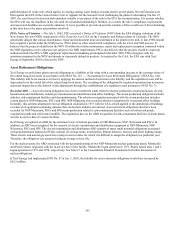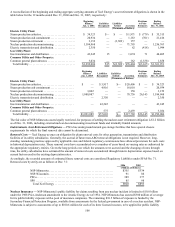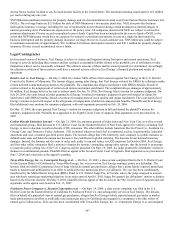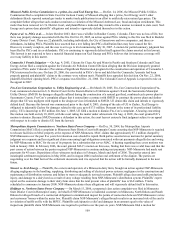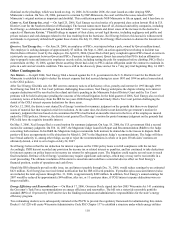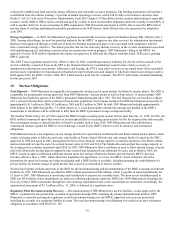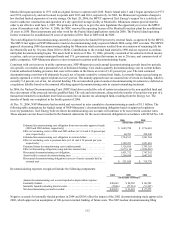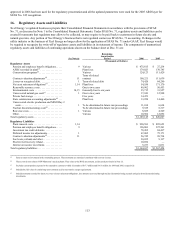Xcel Energy 2006 Annual Report Download - page 113
Download and view the complete annual report
Please find page 113 of the 2006 Xcel Energy annual report below. You can navigate through the pages in the report by either clicking on the pages listed below, or by using the keyword search tool below to find specific information within the annual report.103
Cunningham Station Groundwater — Cunningham Station is a natural gas-fired power plant constructed in the 1960s by SPS and
has 28 water wells installed on its water rights. The well field provides water for boiler makeup, cooling water and potable water.
Following an acid release in 2002, groundwater samples revealed elevated concentrations of inorganic salt compounds not related to
the release. The contamination was identified in wells located near the plant buildings. The source of contamination is thought to be
leakage from ponds that receive blow down water from the plant. In response to a request by the New Mexico Environment
Department (NMED), SPS prepared a corrective action plan to address the groundwater contamination. Under the plan submitted to
the NMED, SPS agreed to control leakage from the plant blow down ponds through construction of a new lined pond, additional
irrigation areas to minimize percolation, and installation of additional wells to monitor groundwater quality. On June 23, 2005, NMED
issued a letter approving the corrective action plan. The action plan is subject to continued compliance with New Mexico regulations
and oversight by the NMED. SPS is evaluating implementation of a similar project at Maddox Station. These actions for Cunningham
and Maddox are estimated to cost approximately $4.2 million through 2008 and will be capitalized or expensed as incurred.
Construction and liner installation of the new pond has been completed. A permit application for discharges from the pond has been
submitted to the NMED. It is expected that the pond will be ready to be placed into service when the NMED issues Cunningham a
permit. The permitting process for Maddox has begun.
Other Environmental Requirements
CAIR — In March 2005, the EPA issued the CAIR to further regulate SO2 and nitrogen oxide (NOx) emissions. The objective of
CAIR is to cap emissions of SO2 and NOx in the eastern United States, including Minnesota, Texas and Wisconsin, which are within
Xcel Energy’s service territory. Xcel Energy generating facilities in other states are not affected. CAIR addresses the transportation of
fine particulates, ozone and emission precursors to nonattainment downwind states. CAIR has a two-phase compliance schedule,
beginning in 2009 for NOx and 2010 for SO2, with a final compliance deadline in 2015 for both emissions. Under CAIR, each
affected state will be allocated an emissions budget for SO2 and NOX that will result in significant emission reductions. It will be
based on stringent emission controls and forms the basis for a cap-and-trade program. State emission budgets or caps decline over
time. States can choose to implement an emissions reduction program based on the EPA’s proposed model program, or they can
propose another method, which the EPA would need to approve.
On July 11, 2005, SPS, the City of Amarillo, Texas and Occidental Permian LTD filed a lawsuit against the EPA and a request for
reconsideration with the agency to exclude West Texas from the CAIR. El Paso Electric Co. joined in the request for reconsideration.
Xcel Energy and SPS advocated that West Texas should be excluded from CAIR because it does not contribute significantly to
nonattainment with the fine particulate matter National Ambient Air Quality Standard in any downwind jurisdiction.
On March 15, 2006, the EPA denied the petition for reconsideration. On June 27, 2006, Xcel Energy and the other parties filed a
petition for review of the denial of the petition for reconsideration, as well as a petition for review of the Federal Implementation Plan,
with the United States Court of Appeals for the District of Columbia Circuit. Pursuant to the court’s scheduling order, briefing is
expected to be finalized in September 2007.
Under CAIR’s cap-and-trade structure, SPS can comply through capital investments in emission controls or purchase of emission
“allowances” from other utilities making reductions on their systems. Based on the preliminary analysis of various scenarios of capital
investment and allowance purchase, Xcel Energy currently believes that with the installation of low NOx burners on Harrington 3 in
2006, there are capital investments estimated at $23 million remaining for NOx controls in the SPS region. Annual purchases of SO2
allowances are estimated in the range of $12 million to $26 million each year, beginning in 2012, for phase I, based on allowance
costs and fuel quality as of December 2006.
In addition, Minnesota and Wisconsin will be included in CAIR, and Xcel Energy has generating facilities in these states that will be
impacted. Preliminary estimates of capital expenditures associated with compliance with CAIR in Minnesota and Wisconsin range
from $30 million to $40 million. Xcel Energy is not challenging CAIR in these states.
These cost estimates represent one potential scenario on complying with CAIR, if West Texas is not excluded. There is uncertainty
concerning implementation of CAIR. States are required to develop implementation plans within 18 months of the issuance of the new
rules and have a significant amount of discretion in the implementation details. Legal challenges to CAIR rules could alter their
requirements and/or schedule. The uncertainty associated with the final CAIR rules makes it difficult to project the ultimate amount
and timing of capital expenditures and operating expenses.
While Xcel Energy expects to comply with the new rules through a combination of additional capital investments in emission controls
at various facilities and purchases of emission allowances, it is continuing to review the alternatives. Xcel Energy believes the cost of
any required capital investment or allowance purchases will be recoverable from customers.
CAMR — In March 2005, the EPA issued the CAMR, which regulates mercury emissions from power plants for the first time. The
EPA’s CAMR uses a national cap-and-trade system, where compliance may be achieved by either adding mercury controls or
purchasing allowances or a combination of both and is designed to achieve a 70 percent reduction in mercury emissions. It affects all
coal- and oil-fired generating units across the country that are greater than 25 MW. Compliance with this rule occurs in two phases,
with the first phase beginning in 2010 and the second phase in 2018. States will be allocated mercury allowances based on coal type


